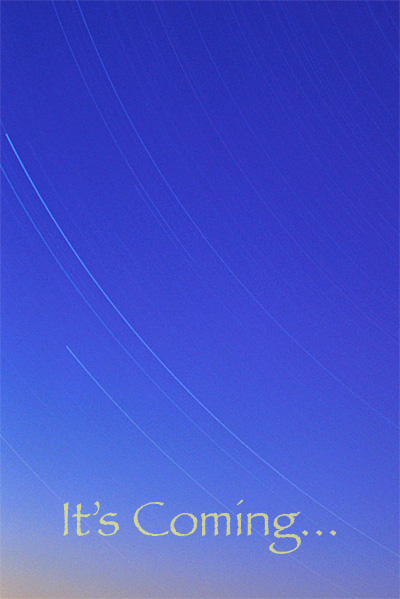Postings by Scott August, about the Native American style flute,
the Pueblo/Anasazi flute, Xiao and the Southwest
Thursday, November 11, 2010
Video Blog: Butch Hall high E NAF
For more information visit the makers page on scottaugust.com
To see and hear more flutes
Tuesday, August 31, 2010
Canyon Echo part 1
For example I heard the following story from a flute maker. It seems another flute maker had posted a new flute on his website along with some sound samples. There were two of them and they both used the same flute recording. The first one did not have any effects, what is called dry, in our case no Canyon Echo. The second sound sample was the same music but with some Canyon Echo added to it to make the flute sound a little nicer. The next day a customer called the flute maker to purchase the flute, but he wanted the one with the "Canyon Echo Option". He thought that the echo was built into the flute...
The truth is that the canyon echo that gives so many flute recordings such a great sound is added to the sound of the flute by devices that modify it electronically or digitally, thereby replicating physical spaces. These effects are really called Reverb, Delay or Echo, depending on which one is being used. You hear these effects on all types music produced in the last 40 or more years, and on all the different instruments on those recordings: vocals, guitars, drums, keyboards, saxophones, etc, not just Native flutes. Also these effects are never referred to in the larger music world as Canyon Echo. So from now on I won't call it that either. Regardless of what you call it, what we are going to do in the next few posts is look at how these effects work, and how to add them to your flute sound. Something you can do whether you play at home, in the studio or on a stage.
Before we dive in it will help if you understand a little about each of the three effects we are going to deal with: reverb, delay and echo, what they do to the sound, how they differ from one another, and then finally how you can add them to the sound of your flutes. This basic explanation will make every thing clearer and easier to understand. I'm going to do this with one post for reverb and another for delay and echo. Let's start with reverb.
Reverb
Reverb is that extra part of the sound that originally came from the place or "space" in which the sound was performed and heard. Reverb is short for the term Reverberation.
Read the full article HERE
Wednesday, August 25, 2010
Flute Quest festival 2010
I flew into Sea-Tac airport last Thursday, August 19th after a two hour flight from LAX. Ironically from the side of the jet that I was on I could see Yosemite National Park, near where the Yosemite Flute Festival will be happening next month. We also flew over Lake Tahoe, Crater Lake, Mt. Hood, Mt Saint Helens and the ginormous Mt. Rainier, which poked it's cone above the clouds that obscured the ground below. At the last moment as we descended toward the airport we broke through the cloud cover and there below us was downtown Seattle, the Space Needle, the waterfront and beautiful Puget Sound.
Waiting for me as I approached the luggage carousel was Chris and Carole. Two volunteers that had the task of driving me around. (I am not using last names to protect the innocent.) They helped me get my bag and then took me out to a nice lunch of fish and chips at a restaurant on the water in the town of Des Monies. Then it was off to see the festival's day ground in Saltwater State Park.
The Site
Saltwater State Park lies in a tiny canyon created by the McSorley creek. This made the area nice and tucked away from the rest of the world. The steep hillsides that lined the valley were tree covered and the valley itself emptied into Puget Sound at a lovely sand covered beach lined with cool sun bleached driftwood logs. Just a few yards inland from this was the park. A nice grassy park with big shade trees, now lined with the white booths of vendors. There was Butch and Laura Hall, Nash, Tom Steward, Michael Graham Allen, Brent Haines, Rick and Linda of Vision Hawk with their two new puppies Chaco and Pecos and many more. In fact there were so great vendors I never made it to all their booths when I had the time between workshops. Finally, there were some great food vendors. Los Agaves had really authentic taco and other Mexican food and the doughnut vendors whose fresh little doughnuts I'll be thinking about for a while!
Set in one corner was a very nice, large stage for day performers. The whole festival was laid out well. It was big but intimate at the same time. As a cornerstone to the event was the WA Flute Circle booth, the hosts and facilitator of Flute Quest. I got a chance to say Hi to Lisa, who was my point person for the event and did so much of the publicity and arrangements for the festival. I also met many of the volunteers who's hard work and dedication was making this all possible. Later that night everyone there was invited to a get together of food, including some great chicken and salmon. Then it was off to the hotel to rest before the first day.
Day 1
The first day of the festival was nice and cool. A perfect break from the heat of LA. Up first for me was a workshop on the Anasazi flute. I had at least 10 people attending and they all did great! Everyone, from the more experienced to the beginner, got a tone. We went over ways to help get a sound, exercises to improve one's tone and looked at three of this flute scales. I felt everyone did very well and hope they all keep playing, especially those that had less experience. After the workshop I gave a couple private lessons right by the water. It was really one of the most picturesque setting I've ever given a lesson in. Not unlike Musical Echoes, with the water right there.
Before I knew it, it was time to get to the Knutzen Family Theatre where the evening concerts were to be. There I meet Laura, Steve, Amy and Bret who helped myself and Rona Yellow Robe set up and get our "act" together. The venue was really nice. It held 250 persons but was still very intimate in it's layout. The seats come right down to the stage. Both Rona and myself had video presentations for our respective sets and the screen was very big, while the lighting could still be put on both of us during our performances. Most venues only have a strip of lights and either I'm in the dark or the screen is washed out. So this was a welcome perk.
There was a great audience that night. Very enthusiastic and warm. I had a great time during my performance and with the great feedback coming from the crowd I really got into the music. I don't know if anyone got photos of my performance, but if they did I'd love to see them.
Day 2
The second day I had the first of a two part Songwriting/Improvisation workshop. We began by talking about one of the more common ways to quickly come up with a tune by using building blocks derived from the very first notes that come out of your flute. We also discussed how to balance new musical thoughts with repeated ones and some of the basic shapes that a melody can take. I enjoy giving this workshop as a lot of people think that writing a song for their flute is a big giant challenge. But it's really not if you know how to break it down into small components.
After the workshop I gave a couple lessons and sat at the table where the artists could sell their stuff. That gave me the chance to meet some people and talk a little with them.
That night was Joe Young and Mary Youngblood's performances.
Day 3
The last day had a little drizzle in the morning but the sun broke through by the middle of the day. For me it was part two of my Songwriting/Improvisation workshop. We continued where we left off and expanded the small melody that we looked at the day before into a full, short tune for NAF. We also talked a little about rhythm and tempo, and more ways to easily grow ideas into full songs. All the while I was illustrating the concepts on a white board, which, as is normally the case, became a big messy doodle. Some mention was also made about northern Kokopellis vs. southern ones but we won't talk about that here...
Seattle
When the festival ended at 3 pm Joe, his wife LaRee, Ken, our friend Sharon, (who was kind enough to help me sell my CDs during my performance) and myself went off to Seattle to visit Pike Place Market, the Experience Music Project and the Space Needle. We had a great time even though Lark in the Morning has closed the store in Pike's Place. I also wanted to visit the original Starbucks store too. A pilgrimage for my caffeine habit. There were a lot of very talented and unusual musicians playing throughout the market. The Experience Music Project was interesting especially if you're into electric guitar. There is also a Sci-Fi museum in the building too. The big bummer, for me anyway, was that the Space Needle was closed for a private event! Maybe next trip.
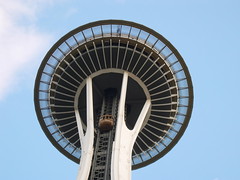
I posted a few photos on flicker
Here are the photos from others in a forum on the portal
© Cedar Mesa Music
Tuesday, August 10, 2010
How to Buy a Microphone
Of all the emails I get with questions about Native American flutes one of the most common is about what kind of microphone to use for the Native flute. Even if you're not recording a microphone can be used for amplifying your sound when you're playing live. Therefore knowing a little about mics and how you are going to use them will help you decide what kind of mic to purchase
There are two basic type of microphones. But before we get into them and look at how they are different, let's talk about how they are the same: The patterns in which they pick up sound. When I say pattern I'm talking about the shape that we use to represent the direction in which they will pick up a sound. There are a number of patterns but we'll look briefly at three: Cardioid, Bi-Directional or Figure Eight, and Omnidirectional. Some microphones will only use one of these patterns, but many have a switch that lets you choose which one you want to use.
Omnidirectional
The easiest to understand is Omnidirectional. Omni is Latin for all. So an Omnidirectional mic picks up sounds from all directions. No matter where the sound source is in relationship to the mic, it will be picked up equally.
Bi-Directional
Bi-Directional, or figure eight means that the mic will pick up sounds coming from both the front of the mic and the rear, but not the sides. This pattern when plotted on a graph looks like a figure 8, with the mic being in the middle of the two circles that make up the number 8.
Cardioid
A mic with a Cardioid pattern picks up sounds only from in front of it and just a little to the sides if the sound is near the mic. The pattern on a graph for this type of mic looks like a heart, or in truth more like a the outline of a plum. The mic is by the two upper lobes of heart.
If you're interested in seeing what these patterns look like on a graph you can find them here. You'll notice other patterns that we haven't covered here. But these are variations on these three basic types.
Native Flutes = Cardioid
For the most part, when talking about Native flutes, you'll want to use a mic with a cardioid pattern. You'll be playing in front of the mic and really don't want any other sounds to be picked up from the sides or back.
Different Types of Microphones
So now that we've looked at how mics are similar, let's look at how they are different. There are several different types of microphones but for the Native flute there are really only two that you'll need to worry about: Dynamic and Condenser. I'm not going to go into how these two types of microphones work, but rather talk about how they are used. If you want to know more about the circuitry involved there is a lot of information out there. You don't need to know this to use a mic. Let's look at dynamic mics first.
Dynamic Microphones
Dynamic mics are the types of microphones you see on a live stage. Singers use them on stage, as do instruments that need to be mic'd. They are, for the most part, inexpensive, can take a beating, and don't feedback as easily as Condenser mics. A decent, all purpose, dynamic mic can be purchased for $100 - $150. Dynamic microphones generally only come with a cardioid patter.
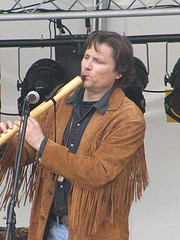 When playing a Native flute into a dynamic mic you want to get the flute's true sound hole, the one in front of the block, right up to the microphone. This is due to the fact that these mics don't pick up sounds that are not right next to them. (This is why they are harder to feed back)
When playing a Native flute into a dynamic mic you want to get the flute's true sound hole, the one in front of the block, right up to the microphone. This is due to the fact that these mics don't pick up sounds that are not right next to them. (This is why they are harder to feed back)Notice in the photo to the right how I'm trying to get the true sound hole as close to the mic as I can.
One of the reasons why these mics will not pick up sounds that are not close to them is because they are not as sensitive as condenser mics. This also applies to the range of frequencies they will, and will not pick up. As a general rule dynamic microphones will not pick up sounds that are very low in pitch e.g. low frequencies, or ones that are very high in pitch, e.g. high frequencies. Where they start to not pick up high and low frequencies will give each manufacture's model it's characteristic sound. (BTW a graph showing how a mic picks up certain frequencies is called a frequency response curve)
For the most part this lack of sensitivity really isn't a problem where Native flutes are concerned, due to these flutes limited range. Even if you take into consideration low bass flutes and super high flutes, which are well within the average dynamic microphone's frequency response curve.
I use a dynamic microphone when I perform live. How did I pick the mic I use? I didn't really. I just use the mic that came with my Fender Passport PA system. Why go out and buy another mic when the one that came with the PA works just fine? In fact I know that the mic's inability to reproduce really high frequencies works in my favor in that it acts like a filter on any high, breathy, windy or buzzy sounds coming from the flute. Noise that I would filter out anyway!
Condenser Microphones
Condenser microphones are more common for studio recording. Their electronics work in a different way than dynamic mics and are therefore more sensitive. This means that they will pick up sounds from farther away, that are quieter and very low or high in frequencies. Condenser microphones need to be powered, either by a battery in the mic capsule, or generally from the mic pre-amp. This external power is known as phantom power. Most mixing boards and digital I/Os have phantom power built into their pre-amps.
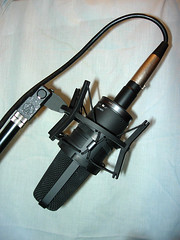 Unlike a dynamic mic, when playing into a condenser mic the sound source, in our case a Native flute, does not need to be right next to the microphone. In fact anything closer then 12" - 18" will over power the mic and cause distortion. It will also pick up noise from your lips and fingers moving. For Native flutes the best way to go is to have the mic in a shock-mount placed in front and above the flute at a 45˚ angle. It's very common to have the mic hanging upside down when recording this way.
Unlike a dynamic mic, when playing into a condenser mic the sound source, in our case a Native flute, does not need to be right next to the microphone. In fact anything closer then 12" - 18" will over power the mic and cause distortion. It will also pick up noise from your lips and fingers moving. For Native flutes the best way to go is to have the mic in a shock-mount placed in front and above the flute at a 45˚ angle. It's very common to have the mic hanging upside down when recording this way.The photo above shows my condenser microphone in it's shock-mount hanging upside down. This is a side view. The front of the mic is to the right.
I use an Audio Technica 4050 for 99% of my studio recording work. I asked several audio engineers what they would recommend for a good, reasonably priced, all purpose instrument mic and this was one of their recommendations. So far I've used it on all of my studio recordings except for a few tracks and have found it to be an excellent mic. When I bought it they cost about $750. They seem to have come down since then. But there are any number of good, reasonably priced mics out there if this is beyond what your budget will allow.
You might be asking yourself, "What mic did he use for the other 1% of his studio recording?" Well on a couple tunes that used a double flute I used a stereo mic, (which I'm not sure gave me the results I was looking for) and on a couple others I used a dynamic mic that was designed for drums! No one has ever mentioned that they can tell the difference and this doesn't surprise me. By the time you do some filtering, a touch of compression and add all the echo and reverb most people can't tell. But leads to another question...
How do you pick a mic for yourself?
So now that I've thrown all this information at you how do you wade through it all an pick a microphone for yourself? The truth is there are a few really easy ways to pick one. They aren't rules necessarily, they're more like guidelines...
1. Where will you use a mic the most?
In the studio or on the stage? If you're going to use it mostly in the studio then you might strongly consider a condenser mic. For anything else, stage, flute circles, family outings, public appearances, Madison Square Gardens..., then get a dynamic mic. It would be wise to not take a condenser mic onto a live stage. It can be done, but It's not worth all the extra hassles and it will pick up every little noise anyone even close to you makes. And that includes your noises as well...
2. What's your budget like?
If you don't have a lot of money you're better off with a good dynamic mic. That way you'll have money for a mic stand, cables and all the other gear the mic plugs into.
3. How quiet is your space?
If you plan to use a mic for only studio recording and your studio is your bedroom, how much unwanted noise is there? If you can't record yourself in a very quiet place then a condenser mic will pick up all sorts of unwanted noise. Computer fans, cars, planes, garbage trucks, neighbors yelling, dogs barking, phones ringing, your spouse / roommate flushing the toilet, the washing machine, birds, loud bees... Better to use a dynamic microphone that won't pick up all these noises. Unless of course you're doing some "Avant-garde, urban noise & flute recording".
I record my live instruments in a walk-in closet with acoustic foam covering the walls. I generally turn off all the phones (which, as my friends know, I rarely answer anyway), and even have my computer in an isolation box to damp down the fan noise. Trust me, when recording, not much is as anonying as unwanted noise that you can't get rid of.
Finally, the last thing to consider is that better equipment doesn't always make for a better recording. Why would I say that? Well what if you purchased some $5,000 microphone (yes, some cost that much) and when you record your flute you hear all this ugly stuff, like wind, buzz and air, in the recording that you don't like? Now you're just going to have to figure out a way to get rid of it. Maybe a less sensitive microphone wouldn't have picked up all that junk in the first place.
Keep in mind that the sound of the flute we hear in our head is not the same as the sound the mic hears. Our brains unconsciously and automatically filter out a lot of wind, air, buzz, fuzz, and other noises from the flute. A mic does not. It's kind of like hearing a recording of your voice. And you love how much your voice sounds... Right?
So if you aren't familiar with how sound works, and how to manipulate it through devices such as EQ, maybe you don't need that state-of-the-art microphone. Maybe an inexpensive dynamic mic is best for your needs and experience. You can always upgrade later.
...Plus, with a "cheaper" microphone, if your playing isn't all that great you can always blame the mic...
Happy Recording!
© Cedar Mesa Music. All rights reserved.
Monday, August 02, 2010
Saturday, June 12, 2010
Peru Journals Part 7 An Inca House: Ollantaytambo
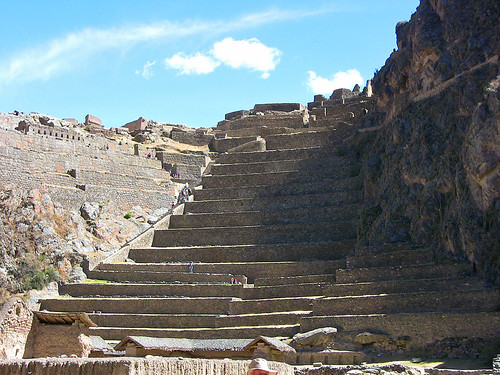
Click to enlarge
Ollantaytambo is about 47 miles from Cuzco, at an altitude of 8850'. Like Pisac, the old Inca town is situated above the colonial town, which itself dates back to Incan times. The word Ollantaytambo is a compound Quechua word. Tambo the word for a town that offers rest and lodging along a road.
Ollantaytambo was a important walled and fortified city. It controlled the road that lead north along the Urubamba river toward the Amazon region. This area, which the Inca called Antisuyo is where the modern name Andes comes from and was one of the four quarters of the Inca world. The people of the Amazon jungle, the Antis were one of the biggest enemies of the Inca. The road also brought many desirable items too. Fruits of all kinds and Coco leaves, which would not grow in the higher altitudes of the Inca homeland.
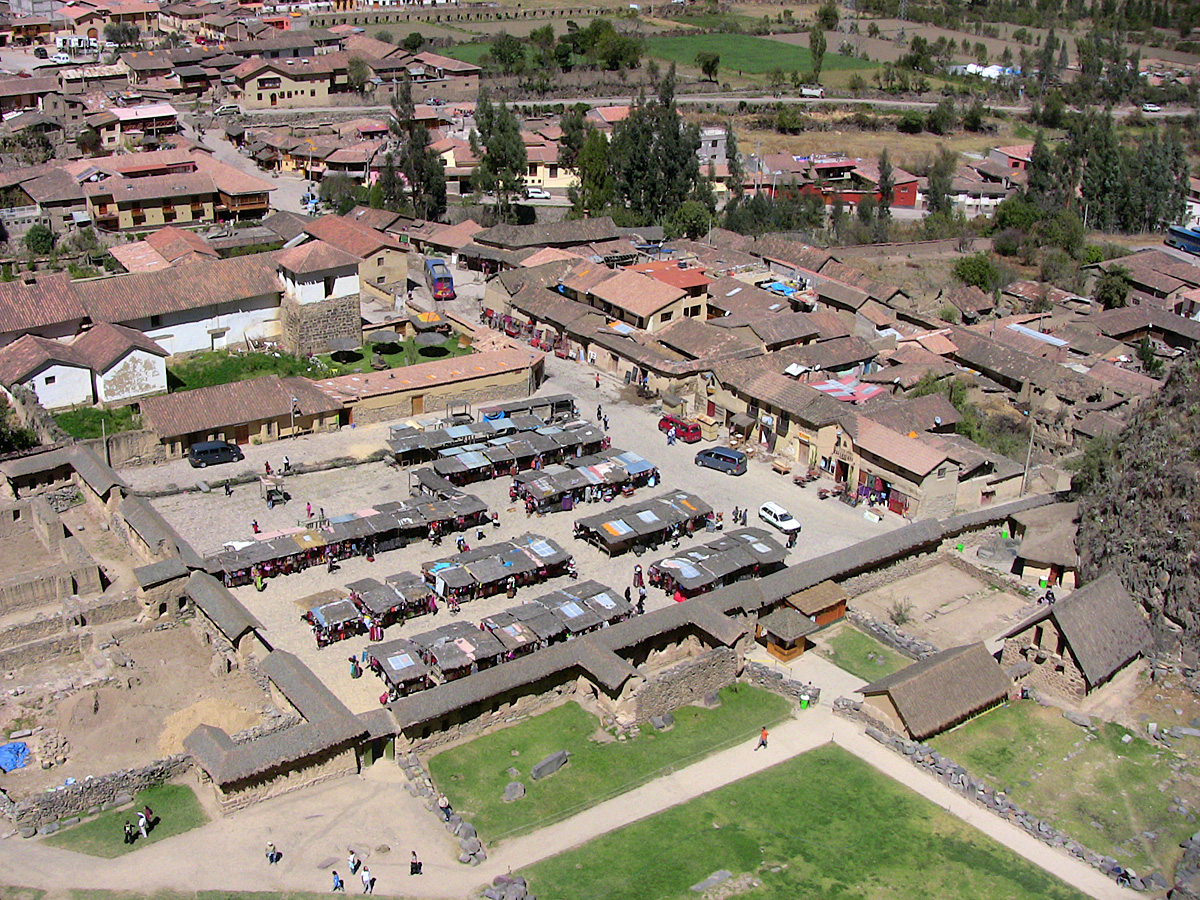
Click to enlarge
In the hills above the town are the terraces of Ollantaytambo and a massive Sun Temple. Down below, in the part of the city that is still lived in, was the Urban sector. Laid out in a typical Incan grid, this is the only place in Peru where one can still see people living in buildings that were used as homes in Incan times. The narrow streets still have their water channels and water still flows in them, although not while we were there. For some reason that even our guide didn't know, they were not flowing that day.
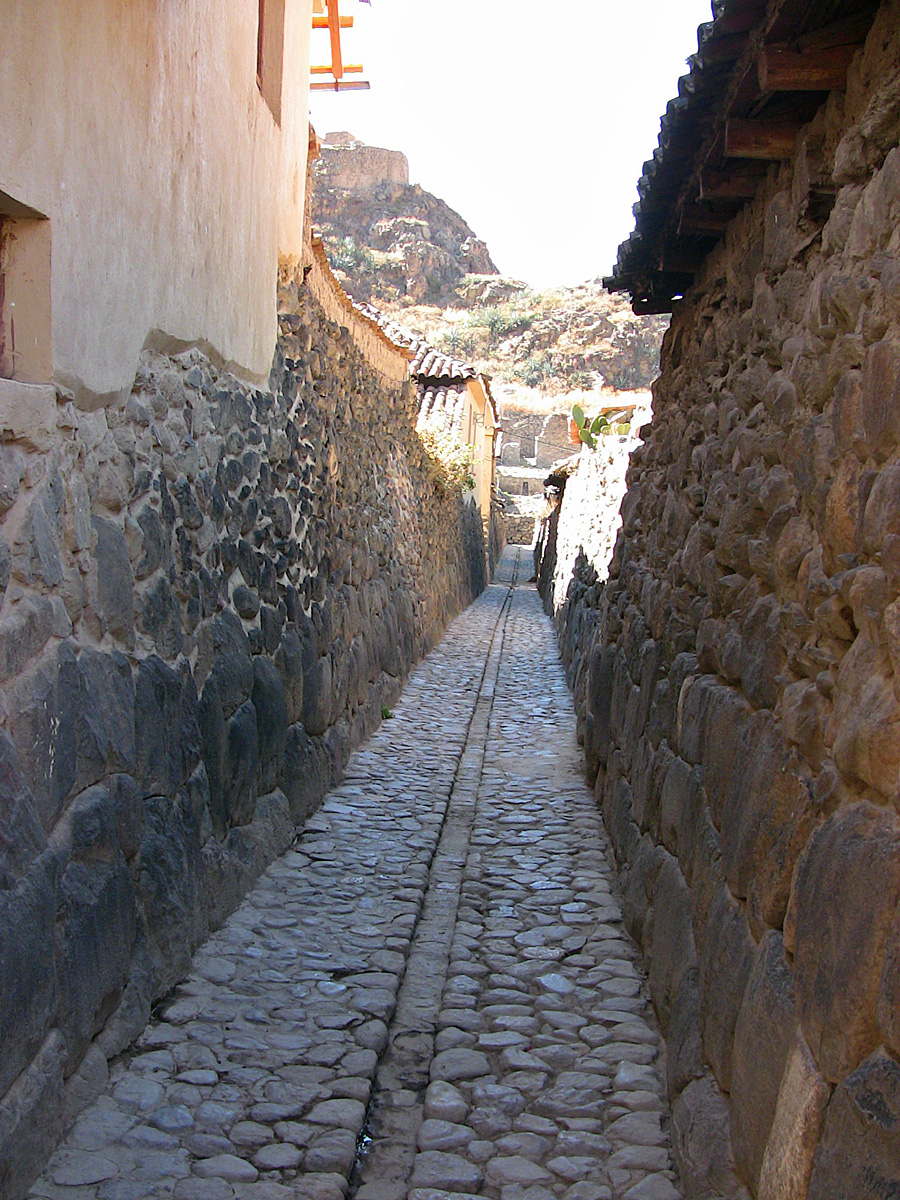
Click to enlarge
Our first stop was to a historic Inca house down one of these narrow Inca streets. We headed down the street aways from the plaza and, as always were mobbed by vendors, mostly women and girls, selling their wares. I bought a knit cap with some llamas in the design and the distinctive Andean ear flaps.

Click to enlarge
As we got farther away from the plaza, and closer to the Inca house, the street got quieter until the only other non-tourist in it was a young girl in traditional costume headed to the plaza to pose for tourist photos. I thought the Inca street would make for a nice location for a photo of her and gave her a Sol to take a couple shots.
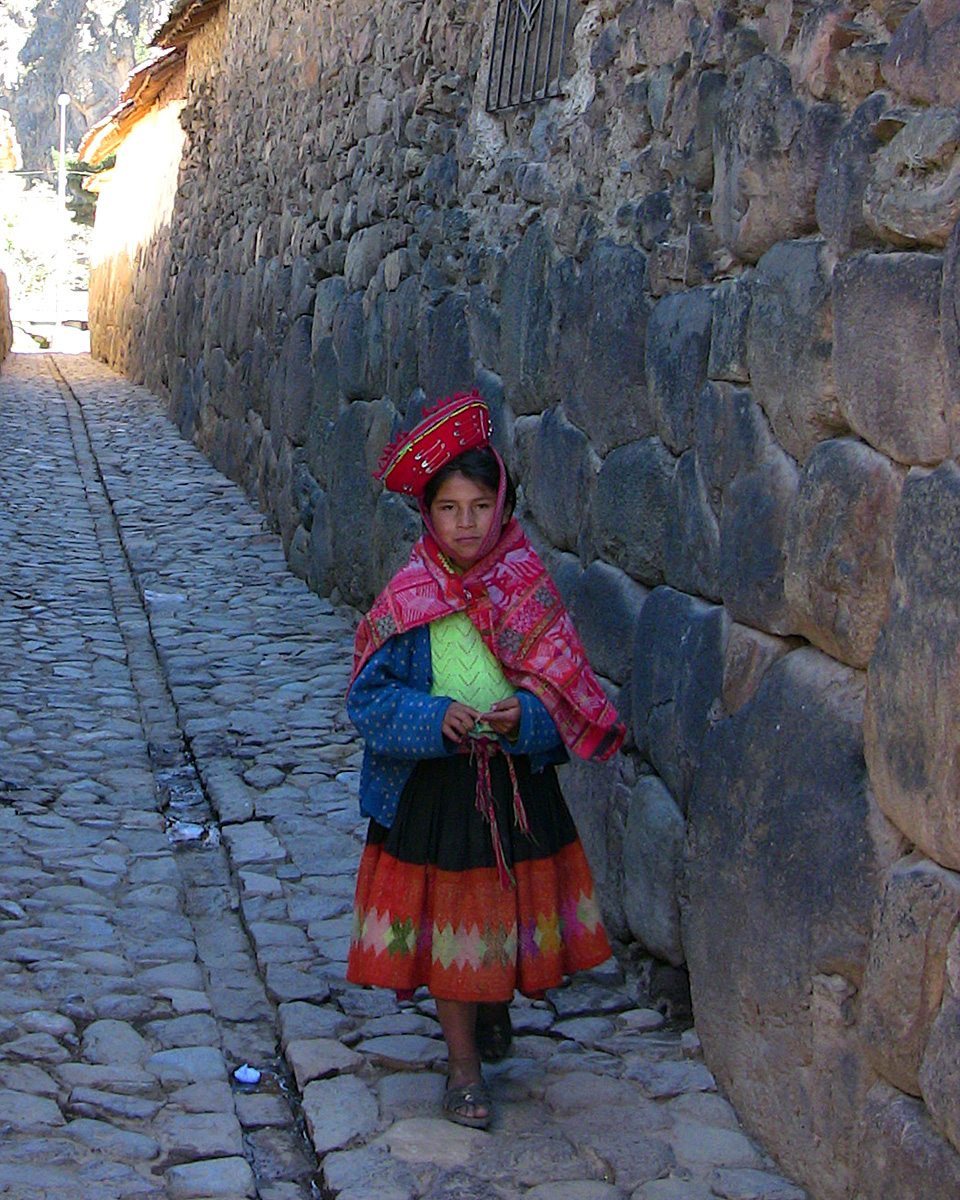
Click to enlarge
Her hat, like all the traditional hats, indicated where she was from. Like most Quecha people, she was quiet, somewhat shy, but very polite. It struck me, how different we must seem to her, as she does to us. What must she make of the throngs of tourists that flock to her town and get excited by her traditional clothing. "Does she go home at night and put on jeans and listen to her iPod", Claire wondered out loud? A good question.
As we would find out that night, during our private dinner in a Quechan home, while we as tourists marvel at the beauty of the landscape, the strong cultural tradition, and allow ourselves to wonder if their life, closer to the rhythms of the earth, is richer than ours. But the truth is their lives are hard, rough and full of struggle. While we as tourists dream of a more "spiritual" lifestyle they want what we have. Cars, TVs, better health care, decent food, a clean, safe environment, a better life for their children.
If we dream and wonder about their lives, they dream and wonder about ours.
I witness this all the time while I'm traveling through the American Southwest. Tourists come from all over the world to see Native Americans, fascinated by their culture and thinking that the Native cultures have the answer to our fast paced modern lives. They want to take an Indian name, do a sweat, and witness a ceremony. They dream of a life closer to the earth, in tune with nature. All the more ironic as our ancestors worked hard to create a life away from nature. Houses, roads, cars, etc. A life sheltered and protected from the elements. The history of most of human kind, especially western culture, has been to create a world of comfort and safety. Yet for some, when they attain that, they think that something is missing in their lives. Maybe it is. I guess each person needs to answer that for themselves.
I too have fallen into the myth of the indigenous life. During my time in Peru my senses were overwhelmed with the sights, sounds and smells of a unknown, exotic culture. But everyday I saw something that made me realize how lucky I am to have the life that my culture provides. Nevertheless, this did not diminish my respect and admiration for the people and culture I was visiting. Their culture has a richness and an authenticity that our modern, mass produced world lacks. But I still want my Starbucks...as it were.
When we reached or destination, the Inca house or wasi, this contrast of life styles was all brought into sharp focus as we laid eyes on their kitchen.
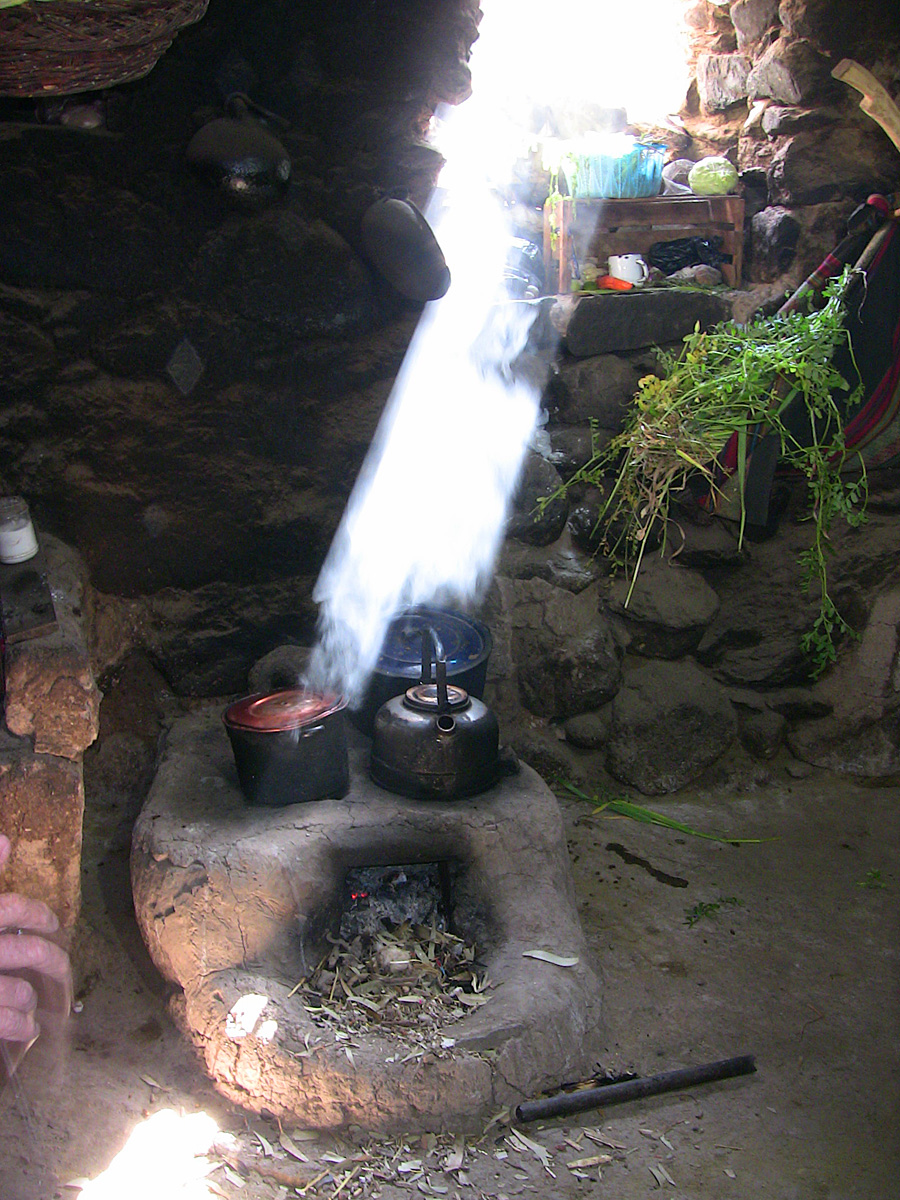
Click to enlarge
Just like the Chicha house, this home contained a very primitive kitchen. In fact more primitive. There wasn't even a small gas stove here. Just wood burning. Huddled up next to the right side was a brown and white Guinea Pig.
The house was part of a larger, traditional compound called a kancha. Most kanchas come in pairs that open onto a common courtyard or patio. The whole compound is walled off from the street, accessed through a small doorway.
The home we were visiting was just one large room. There was very little furniture. The bed was just a pile of blankets on a platform raised off the floor. The floor was the domain of guinea pigs, or cuy which wandered around, busily eating, having no knowledge of their fate. (Where as we humans do, of course...)
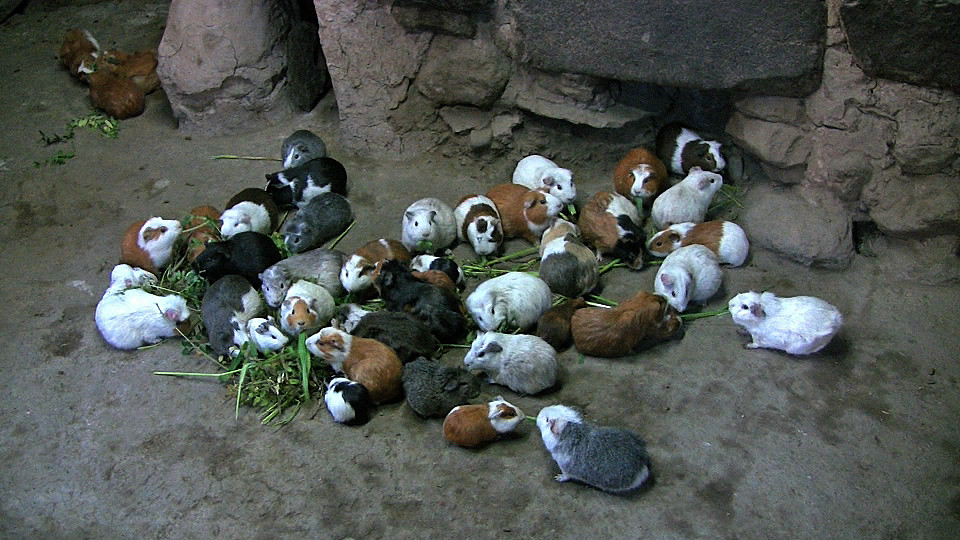
Laid out next to the wood stove were some common kitchen items and other things arranged for us to see. Different potatoes, corn a couch shell trumpet and other items.

Click to enlarge
Above this, set in a niche in the wall were two skulls from the ancestors of the home's current occupants.

Hanging from the roof beams in a bundle of other items was one of the most unusual things we saw in Peru. Unusual to us, anyway. This was the fetus of a Llama. In Prehispanic times the Inca sacrificed llamas to their Gods. These days their fetus are still used as an offering to the Mother Earth, Pachamama. They are buried under the foundation of a building before it goes up, for blessings of health, safety, happiness, wealth and fertility.

Click to enlarge
The wing of a condor hung on the west wall.
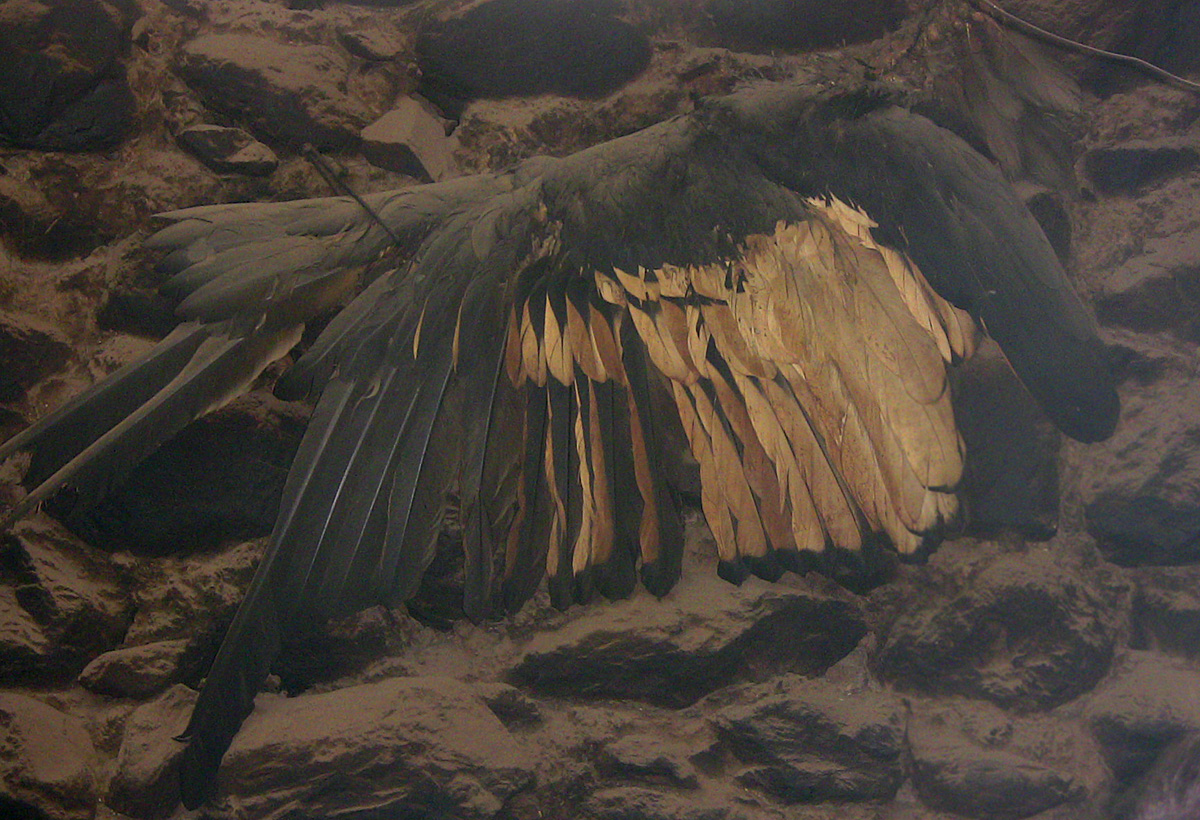
Click to enlarge
To end this post I'm going to let our guide, Fredy, talk about some of the items in the house via an amazingly high quality video clip...
Next we'll take a look at the upper section of Ollantaytambo, with its towering terraces, double-jam doorways and Sun Temple.
All text, images and video © 2010 Scott August / Cedar Mesa Music. All rights reserved.
Previous Peru Journals
Part 1: "Journey to Peru"
Part 2: "Lost in Translation"
Part 3: "Flight of the (Silver) Condor"
Part 4: Inca Pisac
Part 5: The Pisac Market
Part 6: Corn Beer and River Rafting
Thursday, June 03, 2010
Another Path: Improvisation for Mojave Flute
The piece is called Another Path
© 2010 Cedar Mesa Music, BMI
Wednesday, May 26, 2010
Panorama Readers Award
I found out today that Panorama is up for an Ars Design Award. Not only that but they are also allowing the public to vote. Like Cedar Mesa Music, Provue is a little company and needs our support. If you are a fan of my music go over to the Ars Design Award webpage and vote for Panorama. You don't have to register or sign up for anything. Plus you can vote once a day, per computer till May 30th, 2010.
Thanks!
Thursday, April 29, 2010
Musical Echoes 2010, Day 1
As always, the days leading up to a trip to perform are always busy. This is more so when I'm not driving as I have to figure out how to get all my stuff to the location. The week before I shipped product, forgetting to pack my Anasazi book. Then I had to borrow a better suitcase so my shirts and coats wouldn't get too wrinkled. They always do anyway.
The next morning when we arrived at the terminal the TSA line snaked back and forth in a landing above the ticket counter, out the door down to the next terminal and then doubled back on itself. I thought sure I was going to miss my flight. However after spending over an hour in the line I made it to the gate just as boarding started.
I had to stop at DFW, which was much easier to deal with than LAX even though I'd never been there before. They had a train that connects all the terminals like a lot of newer airports. From DFW I boarded a 50 seat jet and head to Ft. Walton Beach.
As I headed toward the baggage claim area there was my "ride", David waiting for me. David is one of the organizers and I liked him right away. A musician himself, he had a strong southern accent and welcomed me to "LA"
"LA?", I replied in confusion.
"Yeah, Lower Alabama, that's what we call it down here".
I felt right at home.
We drove by the park where the festival is held, right on the water of a channel behind a barrier island. I met the sound guy and some others. Everyone was really friendly. Then he dropped me off at my room, which was too nice for the likes of me, and said to call when I needed a ride in the morning. I grabbed a bite for dinner, read some of the book I brought and went to bed. It had been a long day.
The next morning I woke to clear, sunny skies. I grabbed some breakfast at a Waffle House (another first) and then David swung by to take me to the festival.
There I met Dave McCullen in person, we had only dealt online before (another first). Dave, for those of you that don't know, makes amazing PVC rim blown and oblique blown flutes. He has been doing so for a long time. Second perhaps to Michael Graham Allen. I have one of his PVC Hopi flutes. He doesn't sell flutes, but gives them to those lucky few. He works under the name Warrior Wind Flutes. While we were talking I was expressing how lame I felt since I hadn't shipped a blanket for my table. Dave said he could get one and took off. He returned about five minutes later with a really nice blue fleece with a "Native" design on it. When I asked who let him borrow it he replied "I bought it for you". I was so touched, but insisted that I pay him back. He took the money I gave him and promptly bought a copy of Radiant Sky from me! He later came by the both with a Ney and a Kaval. Several of us were lucky enough to get flutes by him. What a treat. I got a Ney and a Kaval and another Hopi flute and an oblique blown flute with a NAF tuning. The last two I can play, the Ney and Kaval, not yet.
Mark Holland had a booth near mine, Jeff Ball showed up later and set up next to me. Also there was Jonny Lipford and Michael Searching Bear. I'd met Jeff and Mark and Jonny before. Jeff I've been lucky to know since 2002 and Mark I met in 2007 I think. They are both great guys and as we all know great flute players. Jonny I meet at the last INAFA convention. He's really coming up with his career and I hoped to get a chance to talk to him sometime during the weekend.
During the day there was a flute competition and then the performing began. All this time the nice sunny sky was becoming darker and darker, the air turned cold and rain threaten to start. I took the stage at 6 PM and as I was playing I could see lightening to the west. It started to drizzle. The sound guy, Bob, told me to keep playing while they dismantled the lights in front of the stage and the speaker stacks. I slogged on as best I could as the lightening got closer, thunder started to clap, the rain increased, and the sound guys yelled back and forth as they lowered the lights in front of me. Finally the rain got so hard it was time to shut everything down. Even with all the commotion I felt lucky. At least I got to play. All of the evening performances were canceled. Once I stopped the brave few that were still in the audience rushed for cover and we all headed out.

Performing during the lightening, thunder and rain
Photo by Cynthia McDonald
The lightening storm was amazing. I don't think I've ever seen so much lightening in one storm. We don't get a lot in LA. A bunch of us went to dinner. Myself, Katy Owen, Deborah Peterson, Lynn Lipford, Michael Searching Bear and his band, and the 2nd place winner of the flute competition, Traci Conley Junge and her family, were just part of the group. While at dinner Katy told us that she'd been hit by lightening three times!
We all hoped for better weather the next day...
Wednesday, April 21, 2010
Anasazi Flute Duet Video
This is is a G Anasazi by Earth Tone Flutes recorded live on March 12, 2010 in Orange County, CA. I recorded the first pass and then looped it back to play a second part against it. This was all done in real time using Digital Performer.
For more information about these flutes check out my articles. To learn how to play one purchase my Complete Guide to the Anasazi Flute
© Cedar Mesa Music. All rights reservered.
Thursday, April 08, 2010
Echoes Radio Interview

ECHOES RADIO INTERVIEW
Echoes Radio is going to be airing an interview with me next week. They posted a teaser on their blog today. It will focus on my latest release Radiant Sky, but include thoughts about all my music.
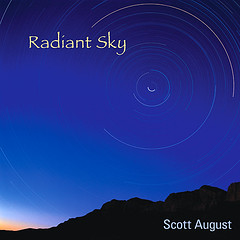
Their interview will air on Monday April 12th and the weekend of April 17th. To find out if you can get Echoes where you are check out their list of stations.
Saturday, March 20, 2010
Chasing the Sun live video
If you are a member of my list keep an eye out for that notice, or visit the Member's Page to find the link.
If you're not a member but would like to be you can sign up here.
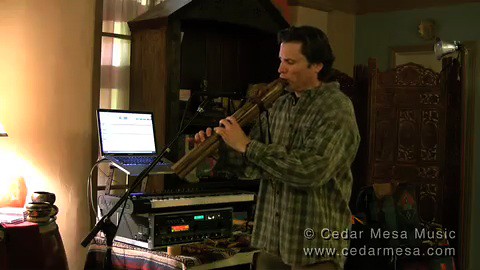
In Harmony,
Scott August
Monday, March 01, 2010
Santa Fe from Radiant Sky. A closer look.
The song Santa Fe, track 5 from Radiant Sky, is the only piece on that release which features a Native American Style flute. This is accompanied by a lot of world instruments: Kalimba, Javanese gongs, Gamelan, Ouds and tons of world percussion. Since the flute plays a prominent part in this tune we'll take a closer look at it here.
THE FLUTE
The flute is a NAF in the key of G minor pentatonic, made of aspen wood by JP Gomez. of Heartsong Flutes This is one of my favorite flutes. It was one of the first ones I got from J.P. and is still my "go to" flute in that key. Here is a photo of me performing "Heart of the Sky" at the 2006 Zion flute festival.

I can say without hesitation that JP's flutes are some of the finest flutes out there. His sound is clear and sings, the finger holes are well placed to be very comfortable and, in my experience, they are always in tune. Now I must admit that even though I've owned this flute for some time and perform live on it every show, until Santa Fe I had not recorded it yet. This did not have anything to do with the flute, but that I wasn't writing songs for NAF much at the time, and not in the key of G. So when I began to sketch out the ideas for Santa Fe I did so with this flute in mind.
THE TUNES
There are about five tunes, or themes in Santa Fe. The rhythmic intro, the three flute themes and the recurring oud/piano breaks. Everything bounces along at a nice toe-tapping tempo and there is a lot of interplay between the instruments. For most NAF lovers however, the flute melodies are the main element that grabs the listener. Rightly so, as it plays the main tunes.
There is a lot of syncopation in the first theme. The clipped duration on the notes throughout the tune accentuate this. The second theme is more driving, although with still a lot of syncopation. The third flute theme is more soaring, with lots of trills and turns. The flute themes are in an AABBCCBBA form. We could simplify this as ABCBA just make it a little easier to get our minds around it. This simplified form, however, does not take the other themes into account, so the piece is slightly more complex.
The first A theme starts at Measure 24, the second at measure 57. Then we hear the B theme at measure 75, the second statement at measure 87. Then at measure 95 we hear the C theme. From that point on it should be pretty easy to hear the different themes.
Here is a sample from Santa Fe with the first NAF A theme and a little of the Oud/Piano theme, or interlude.
Each time a theme occurs there is a small amount of variation. This is either a change of the notes in the tune itself or a change of what is accompanying it, or both. Sometimes new material is added, sometimes exsiting material is removed, or, again, sometimes both happen. It can be really subtle, but the listener notices on some unconscious level. There are no rules.
THE NAF SCORE
For a while now people have been asking me if I'm ever going to publish some of my music in a song book.
This happens to be an ongoing goal of mine, especially the tunes from New Fire. I don't have "release" date, and am not even sure if the demand is high enough to justify it. The work is very time intensive and, up until recently, required the use of an application that I don't use a lot, so I'm always forgetting how to make it do what I want.
A few weeks ago however, I learned that with the latest version of Digital Performer I can now add the TAB finger charts directly into its notation window! So I decided to arrange the NAF themes from Santa Fe in TAB.
If the response to this is positive I'll consider putting more energy into a songbook of the tunes from New Fire.
For the score to Santa Fe I kept a lot of the ornamentation from the recording: turns, short trills, etc., but I cleaned up some of the staccato rhythms so it wouldn't look like a mass of 18th and= 16th note rests. I also didn't worry about notating the bends and chirps that I recorded. (To be honest I don't think that people should even try to play it just like I did when I recorded. Even I don't do that when I perform it live. Where's the fun in that?) However, if you play along with Santa Fe you'll be able to hear the few little bits that might not be in the score. The point, for me, was to present a clean, easy to read notation of the song. One that would be easy for most players to follow.
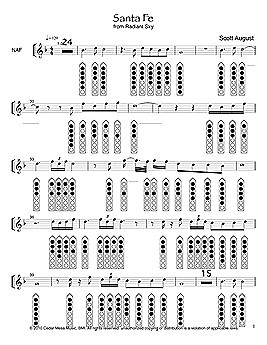
The NAF TAB Score
It's available for purchase HERE as a 8.5 X 11 printable PDF file for $1.99, or for member's of my Email List, for only $1.79.
If you're on my Email List already you can purchase it in the Member's Store. If you'd like to join my mailing list you can sign up on the Email List Sign Up Page.It's easy and free. Plus you get discounts on all Cedar Mesa Music products, Free MP3 downloads and my online newsletter "Echoes From The Mesa"
If you're not a member, and don't want to sign up you can still purchase it below.
If you don't own a copy of Radiant Sky yet, you can purchase a copy here or, if you're a Emailing List Member, in the Member's Store located in the Member's Section.
In
Harmony,
-Scott August
Saturday, January 16, 2010
Radiant Sky available to Member's
However, member's of my Emailing List can get it now and save 15%. This pre-release sale lasts through 02/15/2010.
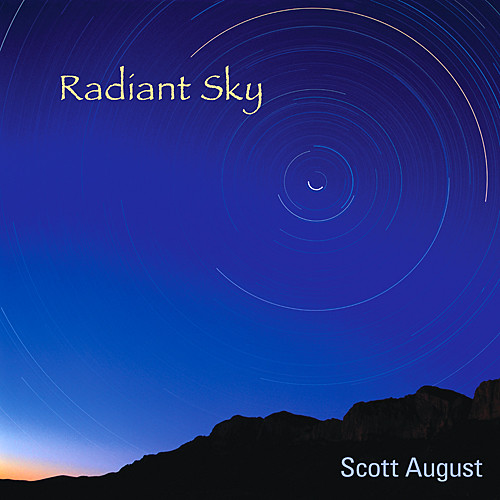
Listen to samples of Radiant Sky
